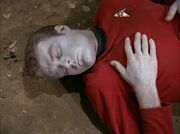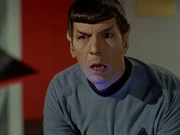mNo edit summary |
(Made the paragraph covering beliefs flow better) |
||
| Line 5: | Line 5: | ||
'''Death''' is the permanent end of all life functions in a [[lifeform]] (or part of a lifeform in the case of tissue damage). It can also mean the absence of life or state of being dead. Many [[culture]]s address this process as it applies to [[sentient]] beings in [[religion|spiritual]] terms, including the holding of [[wake]]s, memorials, and [[funeral]]s following the death of an individual. |
'''Death''' is the permanent end of all life functions in a [[lifeform]] (or part of a lifeform in the case of tissue damage). It can also mean the absence of life or state of being dead. Many [[culture]]s address this process as it applies to [[sentient]] beings in [[religion|spiritual]] terms, including the holding of [[wake]]s, memorials, and [[funeral]]s following the death of an individual. |
||
| − | In [[2365]], [[Nagilum]], in the guise of [[Data]], asked [[Captain]] [[Jean-Luc Picard]] what death is. According to Picard there are two contemporary philosophies. |
+ | In [[2365]], [[Nagilum]], in the guise of [[Data]], asked [[Captain]] [[Jean-Luc Picard]] what death is. According to Picard there are two contemporary philosophies. One is the belief that death is the transformation into an indestructible and unchanging form. According to this belief the purpose of the entire [[universe]] is to then maintain that form in an [[afterlife]] in an [[Eden]]-like place. The other, contrary belief, is that death is simply blinking into nothingness. Picard himself believed that the existence of lifeforms is part of a reality beyond what is currently understood as reality and therefore both philosophies are insufficent. ({{TNG|Where Silence Has Lease}}) |
Death is sometimes perceived as an event that is common to all living things. In [[2366]], Captain Jean-Luc Picard used death and his own mortality as a way to show [[Nuria]] and her [[Mintakan|people]] that he was no different than they were, and certainly not a [[god]] they named "the Picard". ({{TNG|Who Watches The Watchers}}) |
Death is sometimes perceived as an event that is common to all living things. In [[2366]], Captain Jean-Luc Picard used death and his own mortality as a way to show [[Nuria]] and her [[Mintakan|people]] that he was no different than they were, and certainly not a [[god]] they named "the Picard". ({{TNG|Who Watches The Watchers}}) |
||
Revision as of 15:32, 27 September 2010

- "Every life comes to an end when time demands it. Loss of life is to be mourned, but only if the life was wasted."
- - Spock (TAS: "Yesteryear")
Death is the permanent end of all life functions in a lifeform (or part of a lifeform in the case of tissue damage). It can also mean the absence of life or state of being dead. Many cultures address this process as it applies to sentient beings in spiritual terms, including the holding of wakes, memorials, and funerals following the death of an individual.
In 2365, Nagilum, in the guise of Data, asked Captain Jean-Luc Picard what death is. According to Picard there are two contemporary philosophies. One is the belief that death is the transformation into an indestructible and unchanging form. According to this belief the purpose of the entire universe is to then maintain that form in an afterlife in an Eden-like place. The other, contrary belief, is that death is simply blinking into nothingness. Picard himself believed that the existence of lifeforms is part of a reality beyond what is currently understood as reality and therefore both philosophies are insufficent. (TNG: "Where Silence Has Lease")
Death is sometimes perceived as an event that is common to all living things. In 2366, Captain Jean-Luc Picard used death and his own mortality as a way to show Nuria and her people that he was no different than they were, and certainly not a god they named "the Picard". (TNG: "Who Watches The Watchers")
Artificial lifeforms can cease functioning through induced self-destruction.
The study of death is called thanatology. (VOY: "Emanations")
Death may also be seen as a personification, attributed to a single entity, figure, or symbol. In this form, Death is known by many names, one of the more common being the "Grim Reaper". In 2370, the USS Enterprise-D encountered an alien probe that began to transform the Enterprise into an alien city, complete with hieroglyphic symbols, one of which was the symbol for Death (TNG: "Masks"). In 2267, Lazarus equated his parallel universe counterpart as "Death" and "Anti-Life" (TOS: "The Alternative Factor").
Resuscitation
For most lifeforms, death is a permanent state. However, sometimes resuscitation is possible:
- In 2267, Montgomery Scott was killed by the Nomad probe. Nomad subsequently "repaired the unit Scott". (TOS: "The Changeling")
- In the same year, Leonard McCoy was killed by a knight's lance, in an environment that created reality from people's thoughts. McCoy's resurrection was brought about by the power which created the knight in the first place, after Kirk realizes what is going on. (TOS: "Shore Leave")
- In 2285, Spock experienced death, but with his katra having been placed into Leonard McCoy and his body regenerated on the Genesis Planet, he was able to live again. (Star Trek III: The Search for Spock)
- Tasha Yar killed Yareena with a poisoned, spiked weapon. Dr. Crusher revived her. The details of how this was achieved weren't described. (TNG: "Code of Honor")
- Neelix was also brought back from being dead, but as his death did not match his culture's beliefs regarding an afterlife, he was profoundly disturbed by the experience. (VOY: "Mortal Coil")
- The Kobali were capable of reanimating dead lifeforms in order to procreate their species, however the reanimated corpse would have a limited memory of his or her prior life. (VOY: "Ashes to Ashes")
- Species 149 were medically advanced and had the ability to reanimate the dead. They were assimilated by the Borg, allowing the Borg to reanimate a drone as much as 73 hours after death. (VOY: "Mortal Coil")
- Data noted that his off-switch provided for an experience comparable to death, albeit one that permitted a simple resurrection. (TNG: "The Schizoid Man")
- In 2369, upon his death, Kobliad criminal Rao Vantika transferred his consciousness to Doctor Julian Bashir and continued living in Bashir. (DS9: "The Passenger")
- The same year the Ferengi Grand Nagus Zek faked his death. (DS9: "The Nagus")
Appendices
Quotes on Death
"He's dead, Jim."
- - Leonard McCoy (various)
"How we deal with death is at least as important as how we deal with life..."
"Today is a good day to die."
Related topics

A dead crewman
- After death
- Causes of death
- Casualty reports
- Casuality lists
- Other
Additional references

Spock senses the death of the Vulcan crew of the USS Intrepid
- Episodes:
- ENT: "Dead Stop"
- TNG: "The Bonding"
- TNG: "Half a Life"
- DS9: "The Storyteller"
- DS9: "'Til Death Do Us Part"
- DS9: "To the Death"
- DS9: "Wrongs Darker Than Death or Night"
- VOY: "Death Wish"
- VOY: "Coda"
- VOY: "Barge of the Dead"
- Movies:
- Novels:
- Comics:
